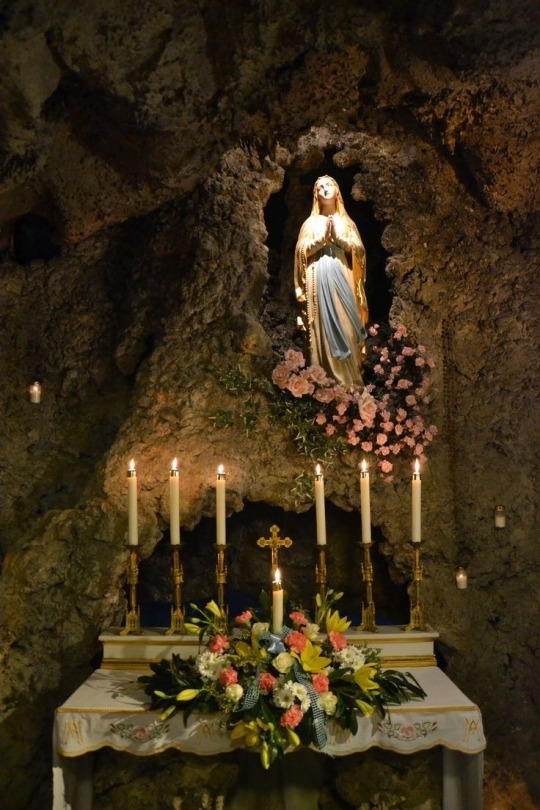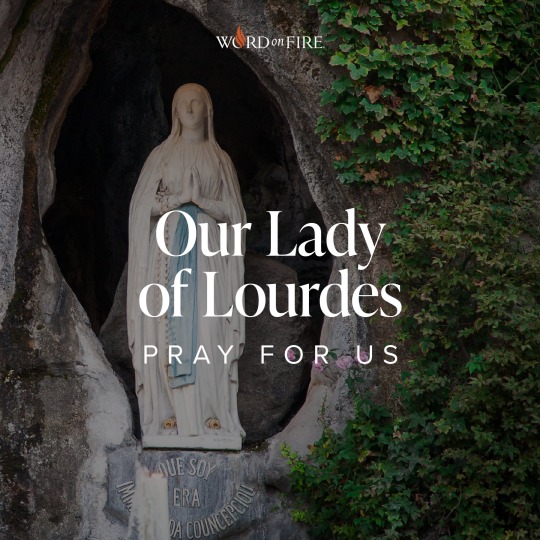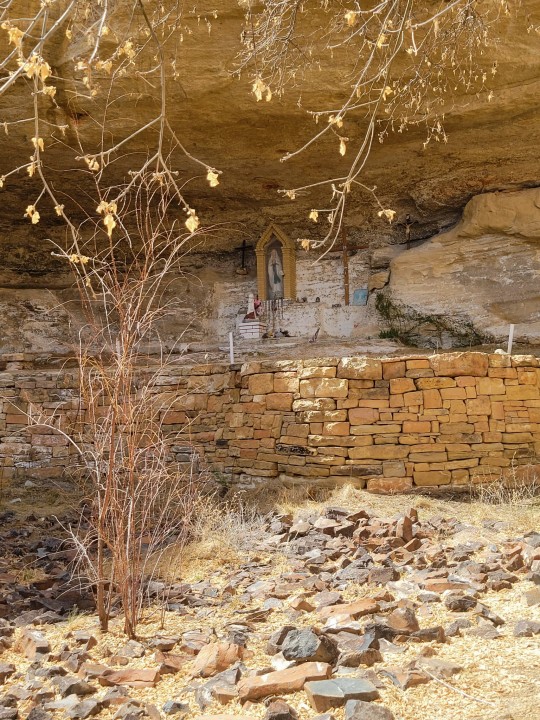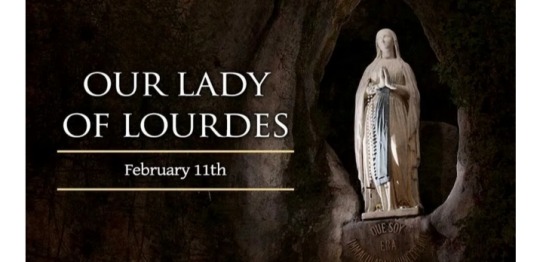#Our Lady of Lourdes
Text

#jesus#catholic#my remnant army#jesus christ#virgin mary#faithoverfear#saints#jesusisgod#endtimes#artwork#Our Lady of Lourdes#pray for us
2K notes
·
View notes
Text

#our lady of lourdes#feastday#catholic#catholicism#christianity#spiritual warfare#blessed virgin mary#our lady
73 notes
·
View notes
Text

A Traditional Catholic holy card from France of Our Lady of Lourdes.
#traditional catholicism#traditional catholic images#traditional catholic modern art#traditional catholic holy card#traditional catholic marian devotion#traditional catholic marian images#traditional catholic marian apparitions#the blessed virgin mary#our lady of lourdes#traditional catholic saints#traditional catholic saints images#st bernadette soubirous
208 notes
·
View notes
Text

#our lady of lourdes#christian#religious#picmix#glitter graphics#old web#old internet#christianity#religious graphics#christian graphics
236 notes
·
View notes
Text

Happy Feast of Our Lady of Lourdes, one and all!!!! 💙🥰💖
20 notes
·
View notes
Text

Holy Mary, Mother of God
Pray for us
#traditional catholic#christian blog#traditional#catholic#biblical womanhood#catholicism#traditional femininity#feminine#pray for me#pray for us#prayer cards#rosary#roman catholic#our lady of the most holy rosary#our lady of lourdes#catholic women#catholic saints#catholic life#catholic church#catholic art#catholic aesthetic#catholic core#catholic academia#christian living#jesus christ our saviour#holy mary#holy card#blessed virgin mary#mother mary#virgin mary
169 notes
·
View notes
Text

Lourdes
#our lady of lourdes#virgin of lourdes#virgin mary#mother mary#catholic#catholicism#ynhart#saturdays are for mama mary
146 notes
·
View notes
Photo

Our Lady of Lourdes
Feast Day: February 11
Patron saint of bodily ills
On February 11th, 1858 Our Lady appeared to St. Bernadette in the cave of Massabielle, Lourdes, France. This began a series of apparitions. During the vision on the 25th of March she told Bernadette, “I am the Immaculate Conception.” Lourdes is one of the most frequented Marian Shrines in the world. It is known as a place of healing, with over 60 miraculous cures that have been recognized by church authorities.
{website}
101 notes
·
View notes
Text
Getting distracted by going down a rabbit hole, I found an obvious explanation for why the French phrase “Que soy era Immaculada Counceptiou” spoken by Mary at Lourdes doesn’t look fully French or Spanish. It was the local dialect at Lourdes in the 1850’s. Considering that both French and Spanish evolved out of Latin, and that Lourdes is in the foothills of the mountains that act as a border between France and Spain, that would explain why the Lourdes dialect was influenced by both French and Spanish and had some different spellings than modern French.
Furthermore, the concept of an Immaculate Conception was clarified in 1854. So when some impoverished 14 year old girl in 1858 claimed that Mary called herself the Immaculate Conception, and the Bishop heard about the claim, he accepted the apparition as genuine because he did not seem to believe St Bernadette would have known about this new dogma from the local community (there has to be more to this story, just like Vatican II is still controversial after 60 years, the Immaculate Conception was probably controversial in the first four years of Vatican approval). So now I have another rabbit hole to go down.
This might not be new to other Catholics, but I just got confirmed last year and there is a lot I don’t know.
#Our Lady of Lourdes#French dialects#French-Spanish dialects#Immaculate Conception#St Bernadette#Que soy era Immaculada Counceptiou#catholic#mother mary#mary
100 notes
·
View notes
Text

10 notes
·
View notes
Text

𝘖𝘶𝘳 𝘓𝘢𝘥𝘺 𝘰𝘧 𝘓𝘰𝘶𝘳𝘥𝘦𝘴 𝘖𝘙𝘈 𝘗𝘙𝘖 𝘕𝘖𝘉𝘐𝘚.
#jesus#catholic#my remnant army#jesus christ#virgin mary#faithoverfear#saints#jesusisgod#endtimes#artwork#follow jesus#jesusiscoming#jesussaves#jesusitrustinyou#holy spirit#our lady of lourdes#pray for us#rosary
291 notes
·
View notes
Text

Saint Bernadette of Lourdes
Bernadette Soubirous (7 January 1844 – 16 April 1879)
#traditional catholic saints#st. bernadette soubirous#catholic#embalming#our lady of lourdes#rosary#prayer#coquette#catholic core#coquette core#sleep
70 notes
·
View notes
Text

Visited a beautiful shrine today.
8 notes
·
View notes
Text
Jesus, Prince of Peace.
Help people in war.
Mary, Mother of Peace.
Help people in war.
God, Gods, Angels, Saints,
Help people in war.
#palestine israel#gaza strip#love not war#war#tw war mention#christian mysticism#lgbt catholic#ecelectic witch#eclectic pagan#jesus prince of peace#our lady of peace#out lady of fatima#our lady of lourdes#angelology#peace and love#peace#oceannotfound blogs
17 notes
·
View notes
Text

On February 11, the Catholic Church celebrates the liturgical memorial of Our Lady of Lourdes, recalling a series of 18 appearances that the Blessed Virgin Mary made to a 14-year-old French peasant girl, Saint Bernadette Soubirous.
The Marian apparitions began on 11 February 1858, ended on July 16 that year, and received the local bishop's approval after a four-year inquiry.
Coming soon after the 1854 dogmatic definition of her Immaculate Conception, the Virgin Mary's appearances at Lourdes turned the town into a popular travel destination.
Thousands of people say their medical conditions have been cured through pilgrimage, prayer and the water flowing from a spring to which Bernadette was directed by the Blessed Virgin.
Experts have verified 69 cases of miraculous healing at Lourdes since 1862.
St. Bernadette also has her own liturgical memorial, which occurs February 18 in France and Canada, and April 16 elsewhere.
Born on 7 January 1844, the future visionary was the first child of her parents Francois and Louise, who both worked in a mill run by Francois.
Their family life was loving but difficult. Many of Bernadette's siblings died in childhood, and she developed asthma.
Economic hardship and an injury suffered by her father cost them the mill in 1854.
Years of poverty followed, during which Bernadette often had to live apart from her parents and work rather than attending school.
In January 1858, she returned to her family, whose members were living in a cramped single room.
Strongly committed to her faith, Bernadette made an effort to learn the Church's teachings despite her lack of formal education.
On 11 February 1858, Bernadette went to gather firewood with her sister and a friend.
As she approached a grotto near a river, she saw a light coming from a spot near a rosebush.
The light surrounded a woman who wore a white dress and held a rosary.
Seeing the lady in white make the sign of the Cross, Bernadette knelt, took out her own rosary, and began to pray.
When she finished praying, the woman motioned for her to approach. But she remained still, and the vision disappeared. Her companions had seen nothing.
Bernadette described the lady in white to them, demanding they tell no one. But the secret came out later that day.
The next Sunday, Bernadette returned to the grotto, where she saw the woman again.
The identity of the apparition, however, would remain unknown for several weeks.
Some adults accompanied Bernadette on her third trip on February 18, though they did not see the vision she received.
The woman in white asked the girl to return for two weeks.
“She told me also,” Bernadette later wrote, “that she did not promise to make me happy in this world, but in the next.”
A group of family members and others went with her to the cave the next day, but only the young peasant girl saw the woman and heard her words.
Over the next few days, the number of people in attendance at the cave swelled to more than 100.
A parish priest, Father Peyramale, became concerned – as did the police.
On February 24, 250 people saw Bernadette break into tears, but only she heard the woman’s message:
“Penance! Penance! Penance! Pray to God for sinners. Go, kiss the ground for the conversion of sinners.”
A larger crowd was there on February 25 – but they were shocked to see Bernadette drinking from a muddy stream and eating weeds.
The apparition had told her to drink the water, and the weed-eating was a penitential act.
Onlookers, meanwhile, saw only the girl’s unusual behavior, and popular fascination turned to ridicule and suspicion.
On February 27, Bernadette made a joyful discovery: the spring from which she drank was not muddy now but clear.
As the crowds continued to gather, this change was noticed, and a woman with a paralyzed arm came to the water hoping to be healed.
Four years later, her case would be recognized as the first miraculous healing at Lourdes.
Public interest continued, and Bernadette heard a recurring message from the vision:
“Go, tell the priests to bring people here in procession and have a chapel built here.”
While others were quick to conclude that Bernadette was seeing the Virgin Mary, the visionary herself did not claim to know the woman’s identity.
As she conveyed the repeated message to Fr. Peyramale, the priest grew frustrated and told Bernadette to ask the woman her name.
But when she did so, the woman smiled and remained silent. Her identity remained a mystery after the initial two-week period.
Three weeks later, on the Feast of the Annunciation, Bernadette visited the cave again.
When she saw the lady, she kept asking to know her identity. Finally, the woman folded her hands, looked up and said:
“I am the Immaculate Conception.”
The seer, devout but uneducated, did not know what these words meant.
She related them to Fr. Peyramale, who was stunned and informed his bishop.
Bernadette saw the Blessed Virgin Mary two more times in 1858: on the Wednesday after Easter, and on the feast of Our Lady of Mount Carmel.
In 1862, the local bishop declared the apparitions worthy of belief.
St. Bernadette left Lourdes in 1866 to join a religious order in central France, where she died after several years of illness on 16 April 1879.
By the time of her death, a basilica had been built and consecrated at the apparition site, under the leadership of Fr. Peyramale.
8 notes
·
View notes
